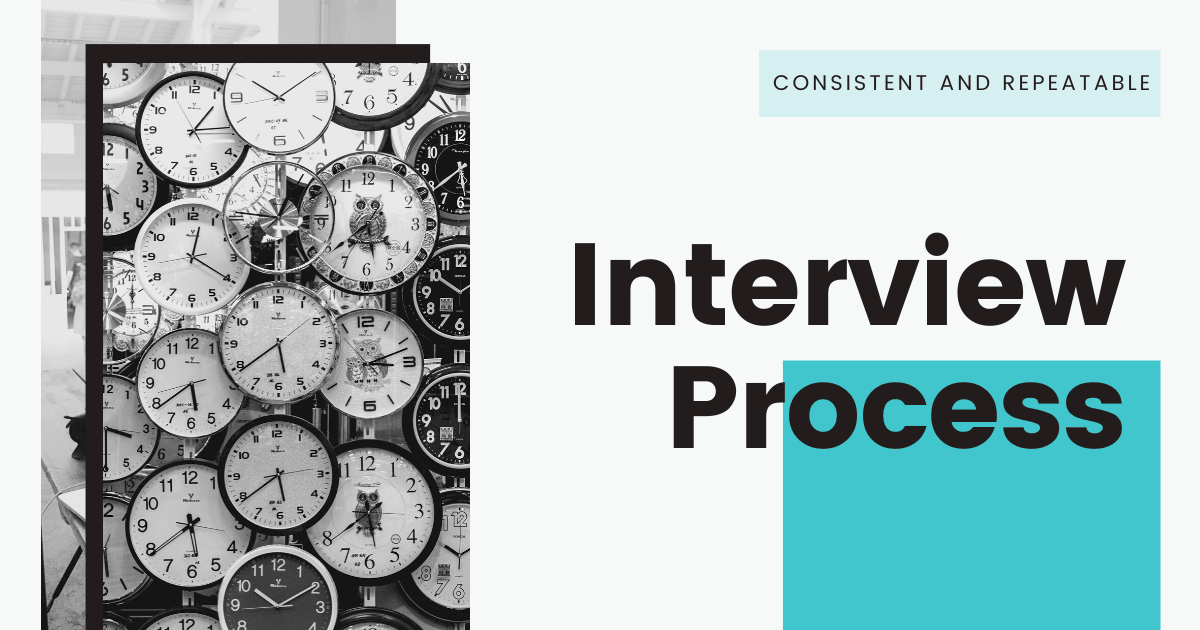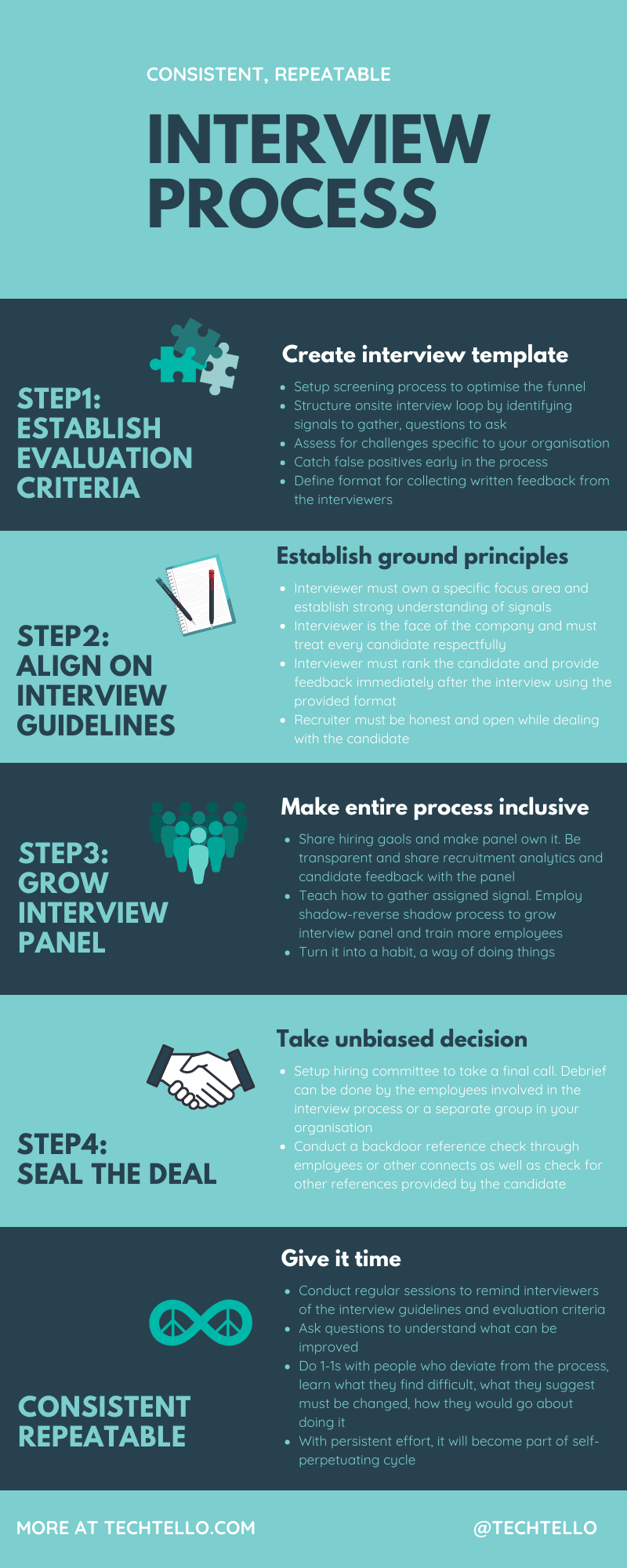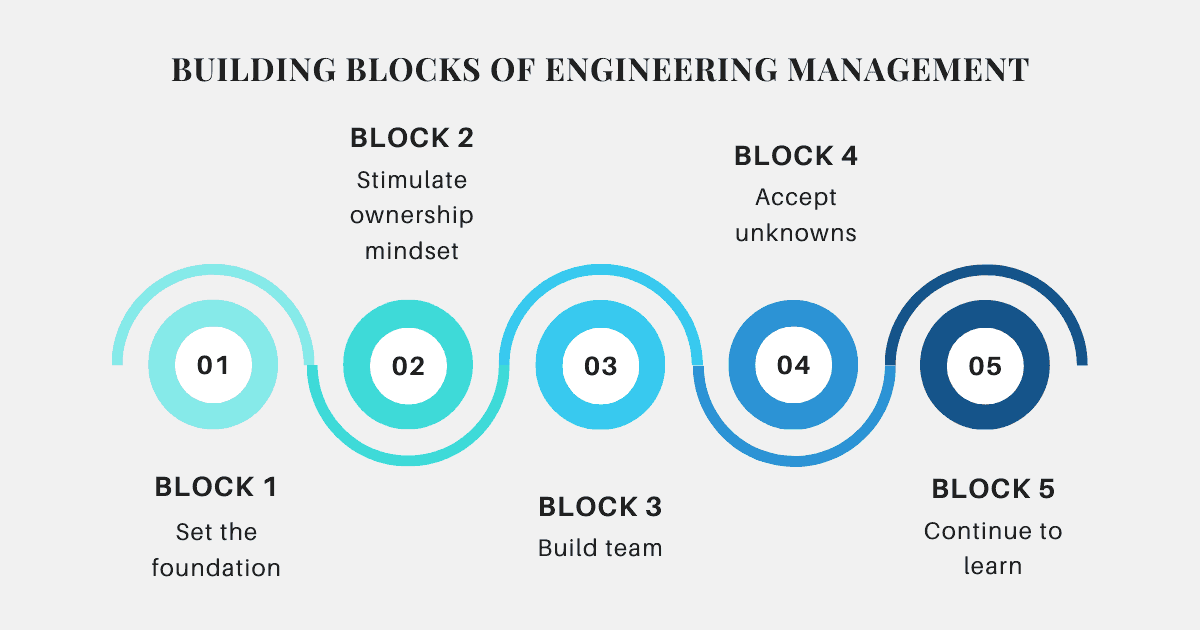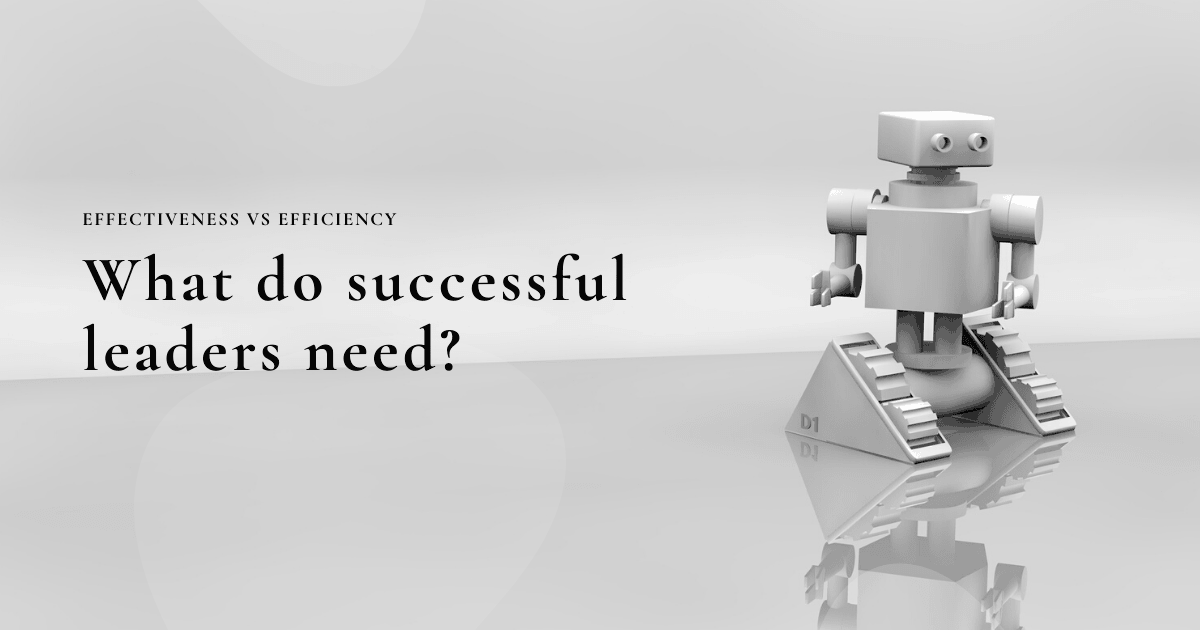How To Setup Consistent Repeatable Interview Process In 4 Simple Steps

Creating a structured interview process helps in objectively assessing the candidate and making effective hiring decisions.
Over the numerous interviews that I have conducted, I have realised that intelligent people with ability to learn and adapt to uncertainty will always be successful in their work as they can easily acquire skills required for the job and will not be threatened by the changes around them. They will find change as a means to learn and improve.
Making the right hiring decision is hard. For anyone who has been involved in hiring, think about the time when you decided about the interviewee within the first few minutes of the interview and then spent the remaining time confirming your bias. We all have confirmation bias and the only way to avoid it is through a solid interview process and evaluation criteria.
Establish and document what to look for in every candidate, how to conduct interviews, what’s required to make a final decision, who will decide. You will be amazed to find that a consistent and repeatable interview process will drive higher productivity and better results.
With rapidly changing technology and fierce competition, companies who do not focus on hiring the right talent eventually fail as it’s only people who can give life to the companies best strategy. Therefore nothing is more important than hiring the right people.
Laszlo Bock, described this well in his book Work Rules
Hiring is the most important people function you have, and most of us aren’t as good at it as we think. Refocusing your resources on hiring better will have a higher return than almost any training program you can develop
I have identified 4 key steps for developing an effective interview program that’s simple to understand and integrate. Lets learn about them:
STEP1: Establish criteria for evaluating the candidate
People behave and perform differently in different environments. A candidate with a solid resume and reference may not deliver the same results in your setup. Evaluating the candidate to make sure they will thrive in your environment is more important than checking for specific technical skills. It’s not that technical skills are not important – they are simply secondary when it comes to hiring the right talent. Setting up an effective evaluation criteria requires you to consider the following:
Screening process to filter and optimise onsite interviews
First step in the process is to optimise the funnel. Given the huge number of positions to fill and the limited interview panel, it’s essential to cut down on candidates who qualify for onsite loop.
Create a screening process to filter profiles and avoid wasting time by meeting only qualified candidates for a face to face interview. It can be in the form of an online coding test, home assignment or telephonic conversation based on role and seniority.
This first filter can be a powerful way to value and efficiently utilise interviewers time.
Structure onsite interview loop
Understand the required competencies for each role and establish the number of interviews required to evaluate a candidate on these competencies e.g. problem solving, coding, product insights, architecture.
More interviews do not necessarily help with better decisions. In my experience, 4-5 interviews with clear expectations from each round should be enough to decide.
Next, define the evaluation criteria for each round – signals to gather, examples of questions to ask to help gather those signals. For some roles, if you need people with specific technical skills or specialised experience, it’s important to cover that in the criteria.
I also recommend giving candidates a real problem to solve – ones that you are solving internally. It provides them with a good view of the space in which the company operates, experience problems first hand and in turn excite them to join the company.
Assess for challenges specific to your organisation
Find out how many employees leave within the first few months citing “I didn’t sign up for it”.
Working for some companies (especially startups) isn’t easy. It’s important to be authentic and provide a realistic view of the work environment, challenges ahead and then evaluate if the candidate is geared up for it.
Evaluating for company fit is crucial to identify if the candidates aspirations are in alignment with company priorities. A candidate who puts their growth above company needs will do more harm than good.
Situational interviews help in validating such thought processes. Put them in different situations and see how they navigate through it and make decisions. Such interviews help determine if a candidate is a good team player, do they act like an owner, will they require less handholding, do they demonstrate leadership qualities, how they deal with difficult situations.
Also, check for intellectual curiosity – what do they know about the company, do they understand expectations from role and what kind of questions they ask.
In his book The Effective Executive, Peter Drucker reminds us of making right decisions during the hiring process:
“Structuring jobs to fit personality is almost certain to lead to favouritism and conformity. And no organisation can afford either. It needs equity and impersonal fairness in its personnel decisions. Or else it will either lose its good people or destroy their incentive. And it needs diversity. Or else it will lack the ability to change and the ability for dissent”
Catch false positives early in the process
Despite your best intentions and effort, remember the screening process has its limitations and is not perfect. It helps in eliminating a large pool of candidates who clearly do not fit the criteria and should be treated thus.
False positives are a natural part of this process and require defining the interview loop break criteria that prevents such candidates from going through all the rounds.
Recruitment teams must gather feedback about the candidate at the end of each interview and stop further rounds if there are strong signals to not move ahead. Letting these candidates go through all rounds (only to make the candidate feel good) is a complete waste of time and must be better spent in trying to interview someone worthwhile to your organisation.
Written feedback over verbal communication
An interview process is no good without proper data to make a sound decision.
Given the time lag between interview to debrief, even people with good memories find it difficult to state all facts later. A verbal communication also suffers from biased judgement where feedback from another person may impair your decision without any way to validate the original thought process. Hence, it’s important to consider only written feedback while making a final hiring decision.
In my experience, people hardly take time to write good feedback post interviews. Most end up writing 1-2 lines which serves no purpose during final evaluation.
Providing a format for filling feedback form post interview is essential to drive quality decisions. It should cover feedback in a manner such that it’s easy to form an independent opinion about the candidate by simply reading the feedback.
Template: Feedback Form
Signals covered
Questions asked
Response from the candidate
Interpretation and evaluation of that response by the interviewer
Rating: DNME, MSE, ME, EE, OP (Does Not Meet Expectation, Meets Some expectation, Meets Expectation, Exceeds Expectation, Outstanding Performance)
Their decision with 3 top reasons for acceptance or rejection
STEP2: Align recruiter and interviewer on interview guidelines
Interview is not a one-sided process. Candidates evaluate the company as much as the company evaluates them. Interview experience, quality of questions, lack of communication, number of interviews and time to close the position are cited as the top reasons for dropping or not accepting the job offer.
Crafting and publishing interview guidelines will make the entire process more streamlined and establish ground principles to apply during the interview process. Recruiters and interviewers should establish a mutual understanding and commit to following them strictly:
Know your part well
As an exercise, speak to a few interviewers and determine how many of them understand the job description and evaluation criteria for every candidate specific to their assigned set of signals. You will be surprised to learn about their gap in understanding.
Establish that every interviewer must own a specific focus area during the interview (as assigned by the recruiter or HM) and stick to it. They must collaborate with other interviewers to form a strong understanding of the signals and the relevant questions to ask.
They should also refrain from sharing their feedback with other panel members during the course of the interview and bias their judgement.
Remember, the interviewer is the face of the company
Interviewers must treat every candidate respectfully (meet and greet) and be present at the designated time to provide a positive candidate experience.
They should not reveal confidential information about the company. If the interviewer doesn’t have an answer to a specific query from the candidate, they should acknowledge it and involve someone senior from the organisation to answer it. At no point, they should try to fool the candidate or provide misleading information.
Don’t trust memory, only what’s written down
Interviewers must take notes during the interview process inline with their evaluation criteria. They are free to pass on other observations from the interview.
They must rank the candidate and provide feedback immediately after the interview using the provided format. Every recruiter must hold the interviewer accountable to provide this feedback immediately after the interview and not delay to a later date or time.
Feedback should provide useful insights on the signals covered by the interviewer and clearly explain their decision.
Be honest and open while dealing with the candidate
Recruiters should refrain from making false promises or provide inaccurate accounts of the state of affairs inside the company.
They should own the entire candidate lifecycle, their overall experience and give them closure regardless of the outcome. Keeping the candidate updated at every step of the process establishes trust and speaks of professionalism about the company. While not directly visible, it plays a huge role in influencing the final decision of the candidate to accept or reject the job offer.
STEP3: Grow interview panel through inclusivity
Lining up an interview panel that’s capable and experienced to evaluate the candidate is extremely important to make an effective hiring decision.
Invest time in growing the panel from an early stage to drive better conversions and meet hiring targets.
Identify the required number of interviewers per position and evaluation criteria based on hiring schedule (weekly interviews, campus tours, inter city drives). Every interviewer must be equipped to handle 1-2 specific areas (not more) through:
Share hiring goals and make them own it
Make employees part of the hiring goal by helping them understand the process, their role in hiring the best people and why it’s important to get it right. Employees who are connected through a common understanding of the goal and problems will do much better than those who are simply there to play their part.
Be transparent and share recruitment analytics and candidate feedback with the panel. Setup focussed groups to own different metrics, brainstorm on ideas and drive improvement. Most important of all, hold people accountable.
Teach how to gather assigned signal
Encourage interviewers to establish a strong understanding of the signals they need to evaluate and the kind of questions to ask.
Employ shadow-reverse shadow process to grow interview panel and train more employees.
Shadow process requires an employee to attend interviews with other interviewers in the driving seat and learn how it is conducted. Typically after attending 2-3 shadow rounds, an employee can conduct interviews on their own and involve other experienced interviewers to gather feedback (reverse shadow).
Turn it into a habit, a way of doing things
Nothing good can be achieved by rushing or thinking I have done my part and now others should do theirs. Most humans need multiple reminders to register a new process in their minds.
Conduct regular sessions to remind interviewers of the interview guidelines and evaluation criteria. Do not assume that they will simply follow it. Ask questions to understand what can be improved.
Do 1-1s with people who deviate from the process, learn what they find difficult, what they suggest must be changed, how they would go about doing it. Using open ended questions, you can encourage them to find answers on their own and drive better results.
Repeat till it’s ingrained and part of your self replicating culture. It will take time, but will be worth the effort.
STEP4: Seal the deal
In the end if you really care about hiring the right person, it should reflect in how you make the final decision.
With a consistent evaluation criteria designed earlier, decision making can be easy and unbiased:
Setup a hiring committee to take a final call
Debrief can be done by the employees involved in the interview process or a separate group in your organisation.
Most important thing is to ensure that every interviewer provides written feedback per established format and the committee has all the data to make a decision. No single person should make a final decision.
This increases interviewer accountability and reduces bias while making a decision.
Check for references
Conduct a backdoor reference check through employees or other connections as well as check for other references provided by the candidate. It will help collect data on how the candidate worked in previous organisations, their strengths or specific signals that require re-consideration.
JOIN MY NEWSLETTER
We all know that a lot of money goes into hiring and on-boarding the right talent. Optimise for potential hires across multiple positions in your organisation. In case of a rejection by one team, identify if the candidate has the skills that may be relevant to another function or team.
Sometimes people apply for a wrong position and might be better suited elsewhere. It’s in companies best interest to not let such people go by finding the right place for them in the organisation.
Setting up a consistent, repeatable interview process for a company requires time and perseverance. Done right it will be the single most important thing to drive success in an organisation.
I hope to get your comments and feedback on challenges and learnings from the interview process. Drop me a comment below or write to me.





























I always find it exciting and fascinating expecting the article and read.
it indeed help me improve immensely in my practical workplace.Great contribution to capacity building by your institution!